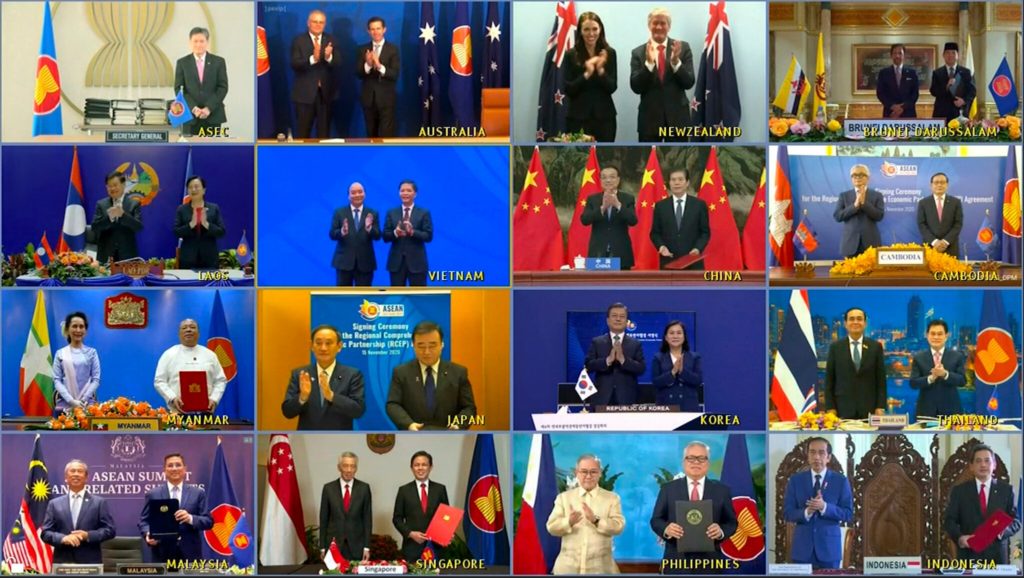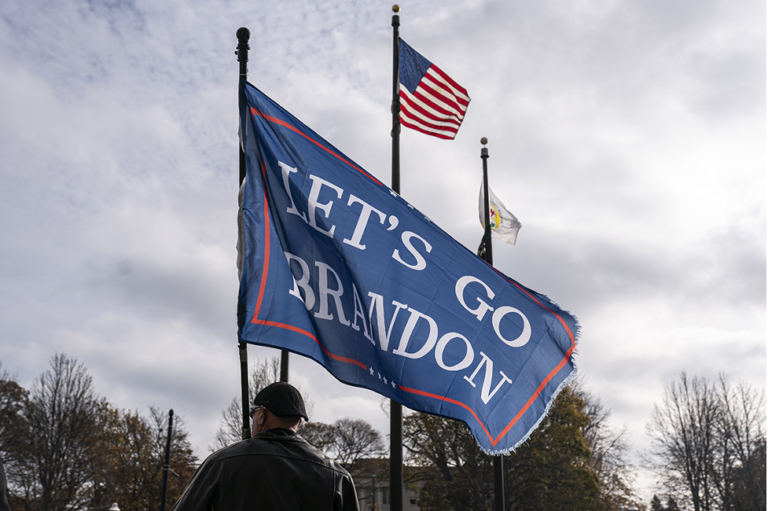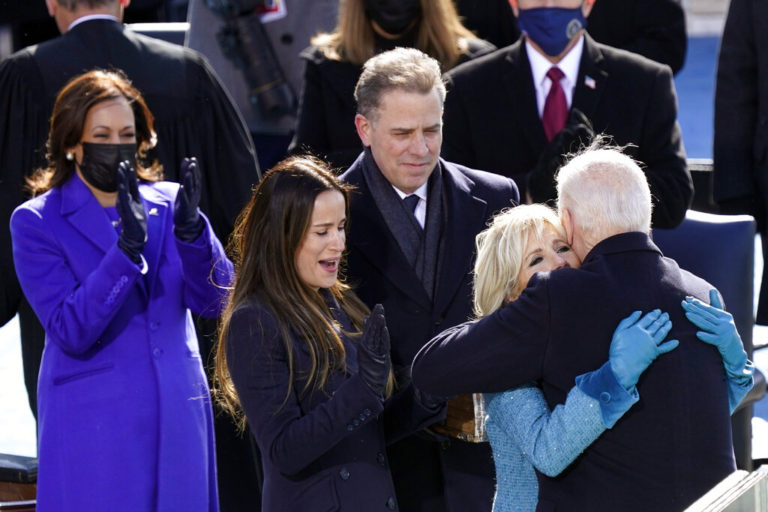
On Sunday, November 15, 15 Asian-Pacific countries signed the largest free trade deal in the world, covering a third of the world’s economy and population. But the headlines focused on one notable absence from the negotiating table.
The Regional Comprehensive Economic Partnership (RCEP) has been in negotiations since 2012; talks intensified amidst the Trump administration’s protracted trade war and the current global recession. Economic journalists have generally characterized the provisions of the deal as fairly “modest,” since 83% of 2019 trade between RCEP signatories was already covered under a preexisting trade agreement.
Beyond the partnership’s commercial significance, the RCEP is hugely symbolic of China’s claim to regional dominance; CitiBank analysts characterized the deal as a diplomatic coup. The RECP comes at a time when the U.S. is shying away from some aspects of engagement with Asia while simultaneously growing more assertive towards China.
Although Biden puts a more tactful face on U.S. foreign policy, this trend shows no signs of abating. The U.S.’s absence from both the RCEP and the Trans-Pacific Partnership is one sign that Trumpian confrontations in Asia may be hard for Biden to avoid.
The RECP refocuses attention on the Trans-Pacific Partnership (TPP)—America’s proposal for an Asian-Pacific trade bloc. The TPP was much more sweeping and substantive than the RCEP, covering not only tariffs and quotas but everything from intellectual property to environmental protection and the role of state-owned companies. At its core however, the TPP was part of President Obama’s “pivot to Asia”—a play to counter China’s growing influence in its own backyard.
In a 2016 op-ed defending the TPP, Obama wrote that the proposal “makes sure we [the United States] write the rules of the road for trade in the 21st century.” He specifically pointed to the ongoing RCEP negotiations as a reason the TPP was urgently needed.
“As we speak, China is negotiating a trade deal that would carve up some of the fastest-growing markets in the world at our expense,” Obama writes.”Other countries should play by the rules that America and our partners set, and not the other way around.”
The TPP included provisions on labor, intellectual property and the environment typically left to domestic policy, but by creating a more comprehensive deal, Obama not only hoped to assuage domestic (Democratic) political concerns, but to set a new standard for 21st-century trade deals. Instead, the TPP may have been the last of its kind.
In his op-ed, Obama was speaking to skeptics in both parties. Although most Americans continued to have favorable views of trade based on polling, the political winds were shifting away from the free-trade equilibrium. When TPP-enabling legislation came up for a vote in 2015, it passed by the narrowest of margins in both the House and the Senate. Republicans voted on an inverse party-line vote to support President Obama’s TPP while Democrats were pressured successfully by labor unions to reject Obama’s trade agenda, to the delight of progressives like Elizabeth Warren. Democratic critics characterized the deal as a giveaway to big business and a further blow to the U.S. manufacturing industry which was just then emerging from a localized recession.
The situation only became more uncertain during the 2016 presidential campaign. Bernie Sanders denounced the TPP as a threat to democracy, pushing his opponent Hillary Clinton to oppose the deal negotiated while she was Secretary of State.
On the other side of the aisle, Donald Trump made trade protectionism a core element of his
“America First” appeal, particularly to working-class voters in key states like Pennsylvania. Trump lambasted the TPP and multilateral diplomacy more generally in a June 2016 speech: “There’s no way to fix TPP. We need bilateral trade deals. We do not need to enter into another massive international agreement that ties us up and binds us down.”
Trump’s rhetoric marked a populist departure from the traditional Republican affinity for free-trade, and by the time the TPP itself came up for a vote in 2016, enough Republicans had sided with Trump so as to put Congressional assent for the TPP in jeopardy.
Soon after taking office, Trump followed through on his campaign promise to abandon the TPP (although the other nations preserved the deal and renamed it the CPTPP). In its stead, Trump engaged in a protracted trade war with China, imposing tariffs on over $400 billion in Chinese goods while depriving Chinese tech companies like Huawei of access to American’s technologies and sanctioning Chinese citizens for alleged corporate espionage. Following on the path of his predecessor, Trump did engineer a “pivot to Asia” and away from the Middle East, but Trump is confrontational where Obama was cautious.
“The tariff man’s” repudiation of free trade and cooperation has extended even further afield. He has turned against allies on both security and trade, beseeching NATO allies to “pay their share” and imposing tariffs on European steel and aluminum (provoking a trade skirmish with traditional allies). He has also pulled out of a slew of international institutions, from the Paris Climate Accords to the WHO to the Iran nuclear deal negotiated jointly with European powers.
Trump’s hostility towards China was welcomed by some in the region, even if his behavior was overly erratic. After Obama’s failed pivot to Asia, Biden “will be deeply scrutinized for any sign of weakness,” according to former Singapore foreign minister Bilahari Kausikan.
The same scrutiny will be expected at home, where both parties have become more hawkish on China. Two top Obama-era officials who are in the mix to join the Biden administration wrote in 2018 that “neither carrots nor sticks have swayed China…from seeking to displace core components of the U.S.-led system.” This re-examination reportedly reflects a broader hardening of views of China in “Washington’s foreign policy establishment” across the political spectrum—a bill placing sanctions on individuals perpetrating repression in Hong Kong passed the Senate unanimously.
As Foreign Policy magazine’s Edward Alden points out, It is fairly common for a Democrat to campaign as a trade skeptic before warming up to trade deals once in office; The Economist notes something similar with rhetoric towards China from both parties. Notably, Obama campaigned much tougher both on China and on trade, but ultimately expended a significant amount of political effort for the TPP and touted his administration’s “unprecedented” cooperation with Beijing.
Biden voted for the North American Free Trade Agreement (NAFTA) and for China’s ascension to the World Trade Organization and lobbied hard for the TPP in Obama’s second term, so he may believe deep down in dealmaking and collaboration, or he may be exhibiting his characteristic tendency to stay in the ideological center of his party. Either way, pressure to stand tall against China is coming from world leaders across the globe and from progressives within his own party, likely leaving Biden with less room for pivoting and compromise than his predecessors.
Biden will depart from Trump in some ways, taking a more measured approach to foreign policy than Trump’s twitter-fueled tumult. For Biden, any trade policy will likely be part of broader foreign policy objectives. To that end, Biden has spoken often of the need to reconnect with American allies. In a January essay for Foreign Affairs, Biden wrote that Western democracies need to present “a united front” against China which “gives us substantial leverage to shape the rules of the road on everything from the environment to labor, trade, technology, and transparency.”
Biden is repackaging Obama’s call to maintain the “rules of the road,” but a full reprisal of Obama’s approach has fallen out of favor. Campaign aides told “The Economist” that Biden had to be “reprogrammed” in a world where the Obama administration’s cordiality and cooperation with China is seen as a political liability.
Cooperation with China on climate change and public health could be revitalized by a Biden administration, but Biden has also committed to a host of policies that would perpetuate America’s growing wariness of globalization and of China. For one, although Biden wrote in January about “resisting a dangerous global slide toward protectionism,” he also pledged not to “enter into any new trade agreements until we have invested in Americans and equipped them to succeed in the global economy” by funding infrastructure, education, and research.
Furthermore, Biden has pushed a multifaceted “Buy American” plan, featuring, among other things, an extra $400 billion in federal procurement of American-made products and an extra “offshoring tax penalty” on profits from production overseas. Biden also promised CNN that all government agencies in his administration “will not purchase” anything not entirely made in America. And in a possible violation of existing treaty (and WTO) commitments, Biden proposed a “cascade of government subsidies to industry” with respect to things like medical devices and communications equipment.
Biden has floated the idea of rejoining the (CP)TPP, although last year he said he would “renegotiate” it to better “hold China accountable.” Regardless, Biden’s immediate priorities lie at home with the pandemic and the related recession, so a significant decision on the TPP or even on Trump’s tariffs will likely have to wait. And a renegotiation would drag the timeline out years further. Even if Biden adopted the TPP as is, it would be near-impossible to pass through a Congress that has only become more wary of grand trade deals since Obama’s unsuccessful attempt to ratify TPP.
Symbolically, Biden will dismantle some excesses of Trump’s foreign policy—rejoining the WHO and the Paris Climate accords. But slogans like “Buy American” and “Make it in America” are not fundamentally different from “America First” and “Make America Great Again.” Protectionism has been adopted across Washington (and across the globe), and this sentiment is likely to persist and strengthen regardless of the change in the White House.


